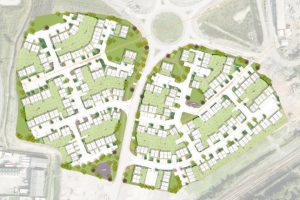Cautious welcome to government’s ‘garden grabbing’ pledge

YORKSHIRE property experts have reacted with caution to the government’s new measures to allow councils in England to prevent “garden grabbing”, the process of houses and flats being built on back gardens.
The problem, which is seen as prevalent in Leeds, Sheffield and Wakefield, has led to an increase in the number of new flats and homes being built on urban green space.
It has become more common in recent years as homeowners look to cash in.
Mark Johnson, head of the planning unit at Dacres Commercial, explained that private residential gardens had been excluded from the ‘previously developed land’ or ‘brownfield’ definition and had now been designated as ‘greenfield’.
“In the short term this may actually increase garden development as those with existing permissions decide to build out as opposed to renew where a refusal is now a possibility,” said Mr Johnson.
“It is also important to note that the ‘greenfield’ tag may prevent garden development in districts which claim to have a sufficient supply of building land, of five years or more, and where they have a greenfield moratorium in place.
“However, where districts have a known shortage of housing land, garden development applications are more likely to be considered favourably.”
Nigel Cussen, partner at the Leeds office of national planning consultancy DPP, said he believed the government’s announcement was “ill thought through and will stifle house-building at a time when the opposite is necessary”.

“Whilst there are understandable concerns from local residents it is important to remember that in many densely populated Yorkshire towns and cities such as Leeds, Sheffield, Wakefield and Bradford, gardens provide some of the only land available on which to build,” he said.
“If we are to avoid building on green field sites then it is important to increase the density of building on existing residential land.
“If this avenue is closed off, then the only remaining alternative is the recycling of employment land – already in short supply in many areas of housing need.”
Mr Cussen added that in a “double whammy” with the proposed abolition of Regional Spatial Strategies (RSS) and the house-building targets that they contain, there was now no compulsion on local authorities to release land to build houses.
“In a two-pronged approach to hold back house-building at a time when the reverse is necessary, Secretary of State for Communities and Local Government, Eric Pickles’ pronouncements will effectively kill whatever green shoots the smaller house-builder and developer may have seen in the past few months. Politically the NIMBY has won for the time being,” argued Mr Cussen.
“It is politically naive to believe you can, or indeed should, prevent and stop house building when there is such a massive demand and need, especially given the government’s pressure on the private sector to provide affordable housing and infrastructure investment.”
The news will be particularly harsh for property developers who build on smaller sites in urban areas that have land earmarked for future developments in areas where sites for larger developments are not available, he said.
Harrogate-based consultant Neil Manock, who specialises in residential development, has launched a guide to help owners assess and realise the development potential of their land or property.
‘Increase the Value of your Property: A practical guide to residential development’ covers a range of development from a single dwelling to property extending to several acres.
Mr Manock said: “There are plenty of people out there sitting on land or property with real potential and now could be a good time for them to assess their opportunities, considering that there is a real need in the Yorkshire and Humber region for affordable new homes.
“With the government’s announcement that greater restrictions are to be placed on garden development, home owners may wish to take this opportunity to assess fully their potential elsewhere.
“This opportunity is not limited to home owners – if you do own an old disused building, a run down or underperforming commercial premises, farmland, or simply a piece of old vacant, scrub land, don’t sell yourself short by underestimating its potential.
Mr Johnson believes that less garden development could mean more housing in the form of strategic urban extensions.
He said: “This could include phased allocated sites not yet commenced; areas protected for longer term housing development and possibly even ‘Green Belt’ land.
“Each local authority area will be different but the change may also result in a greater number of affordable houses being delivered as small sites including garden development rarely contribute towards the provision of affordable housing.”
In addition to the reclassification of gardens, the Department of Communities and Local Government (DCLG) has also introduced a new rule on density levels which will see councils fix their own ranges.
“We would support this change, especially if it means larger dwellings with large gardens can be built in areas where such property is highly sought after,” said Mr Johnson.
“However, in reality, local planning authorities are likely to adopt their own density ranges and still use 30 dwellings per hectare as a minimum because otherwise lower density schemes will ultimately require more development land which in turn creates its own political and environmental problems.”
Decentralisation minister Greg Clark made the announcement on ‘garden grabbing’ to make it easier for what is claimed to be unwanted development.
Announcing the changes last week, Mr Clark said: “For years the wishes of local people have been ignored as the character of neighbourhoods and gardens have been destroyed, robbing communities of vital green space.
“It is ridiculous that gardens have until now been classified in the same group as derelict factories and disused railway sidings, forcing councils and communities to sit by and watch their neighbourhoods get swallowed up in a concrete jungle.
“I am changing the classification of garden land so councils and communities no longer have their decisions constantly overruled, but have the power to work with industry to shape future development that is appropriate for their area.
“This is just the start of whole-scale reform I want to make to the planning system, so councils and communities are centre-stage in a reformed system that works for them, and is not just a tool of top-down policy.”
The measures have been welcomed by the horticultural and wildlife community.








